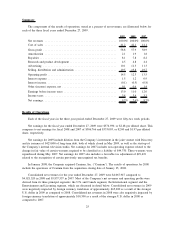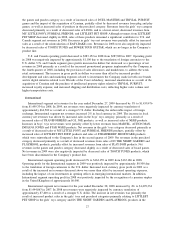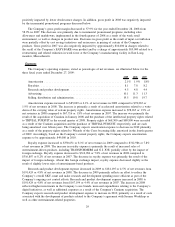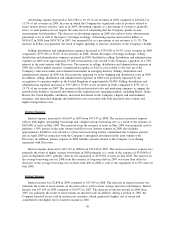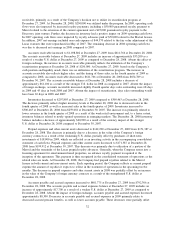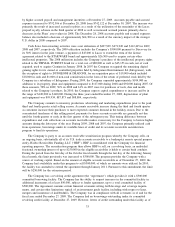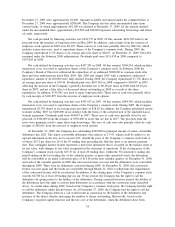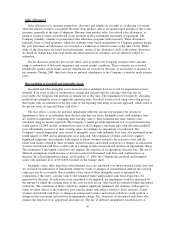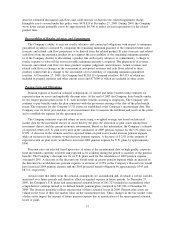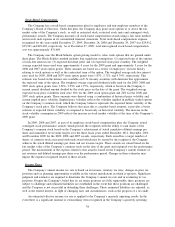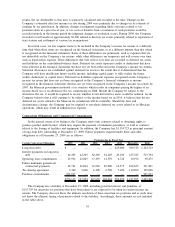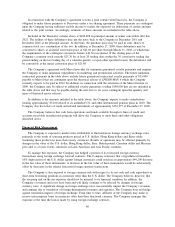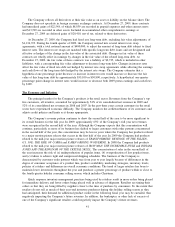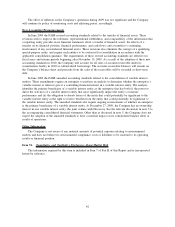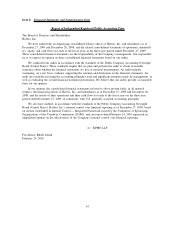Hasbro 2009 Annual Report Download - page 45
Download and view the complete annual report
Please find page 45 of the 2009 Hasbro annual report below. You can navigate through the pages in the report by either clicking on the pages listed below, or by using the keyword search tool below to find specific information within the annual report.
callable the Company has believed that it was more economically beneficial for it to not exercise its right to
call the debentures. Currently, this economic benefit includes a lower cash cost of paying interest on the
debentures than the Company would pay in dividends on the incremental number of shares that would be
outstanding. The Company will continue to assess, at times when it is available, the desirability of exercising
the call option in the future based on the then existing economic circumstances and the Company’s business
objectives. The holders of these debentures may also put the notes back to Hasbro in December 2011 and
December 2016 at the original principal amount. At that time, the purchase price may be paid in cash, shares
of common stock or a combination of the two, at the Company’s discretion. While the Company’s current
intent is to settle in cash any puts exercised, there can be no guarantee that the Company will have the funds
necessary to settle this obligation in cash.
The $350,000 notes due in 2017 bear interest at a rate of 6.30%, which may be adjusted upward in the
event that the Company’s credit rating from Moody’s Investor Services, Inc., Standard & Poor’s Ratings
Services or Fitch Ratings is decreased two levels below the Company’s credit ratings on September 17, 2007,
the date of issuance of the notes. On the date of issuance, the Company’s ratings from Moody’s Investor
Services, Inc., Standard & Poor’s Ratings Services and Fitch Ratings were Baa2, BBB and BBB, respectively.
There were no changes to the Company’s credit ratings from Moody’s Investor Services, Inc. or Standard &
Poor’s Rating Services from the date of issuance through December 27, 2009. In March 2009, Fitch Ratings
upgraded the Company’s credit rating to BBB+. The interest rate adjustment is dependent on the degree of
decrease of the Company’s ratings and could range from 0.25% to a maximum of 2.00%. The Company may
redeem the notes at its option at the greater of the principal amount of the notes or the present value of the
remaining scheduled payments discounted using the effective interest rate on applicable U.S. Treasury bills at
the time of repurchase.
The $425,000 notes due in 2014 bear interest at a rate of 6.125%, which may be adjusted upward in the
event that the Company’s credit rating from Moody’s Investor Services, Inc., Standard & Poor’s Ratings
Services or Fitch Ratings is reduced to Ba1, BB+, or BB+, respectively, or below. From the date of issuance,
May 13, 2009, through December 27, 2009, the Company’s ratings from Moody’s Investor Services, Inc.,
Standard & Poor’s Ratings Services and Fitch Ratings were Baa2, BBB, and BBB+, respectively. The interest
rate adjustment is dependent on the degree of decrease of the Company’s ratings and could range from 0.25%
to a maximum of 2.00%. The Company may redeem the notes at its option at the greater of the principal
amount of the notes or the present value of the remaining scheduled payments discounted using the effective
interest rate on applicable U.S. Treasury bills at the time of repurchase.
Including the debentures and notes described above, the Company has remaining principal amounts of
long-term debt at December 27, 2009 of approximately $1,134,723 due at varying times from 2014 through
2028. The Company also had letters of credit and other similar instruments of approximately $135,277 and
purchase commitments of $251,917 outstanding at December 27, 2009. Letters of credit and similar
instruments include $105,335 related to the defense of tax assessments in Mexico. These assessments relate to
transfer pricing that the Company is defending and expects to be successful in sustaining its position. In
addition, the Company is committed to guaranteed royalty and other contractual payments of approximately
$32,761 in 2010.
Critical Accounting Policies and Significant Estimates
The Company prepares its consolidated financial statements in accordance with accounting principles
generally accepted in the United States of America. As such, management is required to make certain
estimates, judgments and assumptions that it believes are reasonable based on information available. These
estimates and assumptions affect the reported amounts of assets and liabilities at the date of the financial
statements and the reported amounts of revenues and expenses for the periods presented. The significant
accounting policies which management believes are the most critical to aid in fully understanding and
evaluating the Company’s reported financial results include sales allowances, recoverability of goodwill and
intangible assets, recoverability of royalty advances and commitments, pension costs and obligations, stock-
based compensation and income taxes.
35


